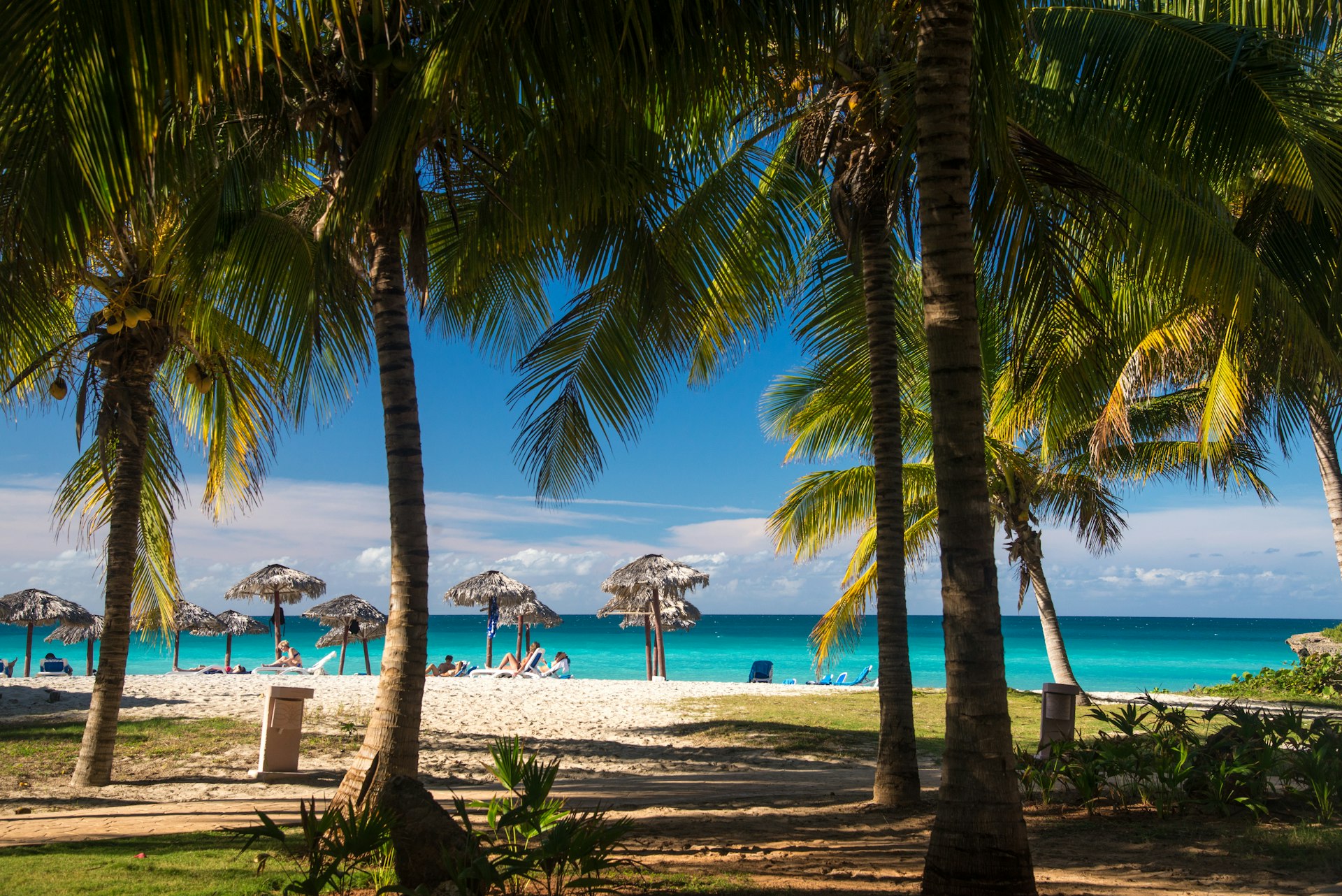
Pack a sunhat and a book of José Martí’s poems and get ready to uncover the buoyant, sophisticated, beautiful magic of Cuba. Fewer restrictions on private enterprise have led to an explosion of creativity, while the culture-dampening effects of globalization have yet to dilute the local charm.
Isolated but eager to advance, the country is buzzing with ideas – here, a free-spirited, student-filled cafe; there, an avant-garde art factory where live music, exhibitions, DJ sessions and creative gastronomy collide with electrifying results.
Discover the world’s most intriguing experiences with our weekly newsletter delivered straight to your inbox.
Here are the top activities that really embody Cuba’s essence and everything this country has to offer.
 Listen out for street musicians in Cuba © Benjamin Rondel / Getty Images
Listen out for street musicians in Cuba © Benjamin Rondel / Getty Images
1. Soak up Cuba’s live music scene
If you’ve been in Cuba for more than a day and still haven’t heard any live music, you’re clearly hanging out in the wrong bars. Welcome to one of the most musically diverse countries on the planet, where melodious guitars rule over background tapes, and singing is seen as just another form of verbal communication.
The traditional genres are merely one groove on a larger record. Cuba has been pushing the musical envelope for decades. From Benny Moré to X-Alfonso, cities like Havana and Santiago de Cuba bleed syncopated rhythms.
2. Sleep overnight in Cuba’s casas particulares
Stay in a private homestay, and you quickly uncover the nuances of everyday Cuban life. There are the rocking chairs on the porch, the bottle of rum on the dresser, the front room full of family heirlooms, the clip-clop of horses’ hooves in the street outside and the animated conversations over breakfast that always seem to end with the words “no es fácil” (it ain’t easy).
Casas particulares in places like Havana and Viñales are positively palatial, while others remain refreshingly down-to-earth; all offer an uncensored view of Cuba that no hotel could ever replicate.
3. Enjoy Cuba’s ebullient festivals
Through war, austerity, rationing and hardship, Cubans have retained their infectious joie de vivre. Even during the darkest days of the Special Period, the feisty festivals never stopped – a testament to the country’s capacity to put politics aside and get on with the important business of living.
The best shows involve fireworks in Remedios, folklórico dancing in Santiago de Cuba, movies in Gibara and every conceivable genre of music in Havana. Arrive prepared to party.
 Cuban architecture retains a definable “Cuban-ness” that sets it apart from other genres © Bim / Getty Images
Cuban architecture retains a definable “Cuban-ness” that sets it apart from other genres © Bim / Getty Images
4. Admire Cuba’s eclectic architecture in Old Havana and beyond
Often spectacular yet rarely constant, Cuban architecture retains certain binding threads, a definable “Cuban-ness” that sets it apart from other genres. Many of the older constructions were built with sugar money using the brutal system of Afro-Cuban slave labor. These buildings provide an uncomfortable testimony to Cuba’s multifaceted culture and sometimes difficult past.
More recent architecture displays a melody of influences, from French classicism to hints of art deco and art nouveau. Visit the Unesco-listed cities of Havana, Trinidad, Cienfuegos and Camagüey, and pick out the details.
5. Go birdwatching
Crocodiles aside, Cuba has little impressive fauna, but its abundance of birdlife more than makes up for its paucity of other animals. Approximately 350 avian species inhabit the shores of this distinct and ecologically unusual archipelago, a good two dozen of them endemic.
Look out in particular for the colorful tocororo (Cuban trogan), the zunzuncito (bee hummingbird), the critically endangered ivory-billed woodpecker and the world’s largest flamingo nesting site. The Gran Parque Natural Montemar is one of many birdwatching highlights.
 Relax on the white sands of Cuba’s beautiful beaches © Tom Jensen / 500px
Relax on the white sands of Cuba’s beautiful beaches © Tom Jensen / 500px
6. Escape to the beach
Uncrowded, extremely varied and loaded with tropical beauty, Cuba’s beaches are famous for a reason. Search around long enough, and you’re sure to find your own slice of nirvana.
There are the long, wide, tourist-heavy beaches of Varadero, backed by massive resorts; the wild, deserted eco beaches of the Península de Guanahacabibes, where turtles lay their eggs; the little-visited black-sand beaches on the Isla de la Juventud, where pirates once roamed; and the unashamedly nudist beaches of Cayo Largo del Sur, where package tourists lounge with mojitos.
7. Understand Cuba’s revolutionary heritage
An improbable escape from a shipwrecked leisure yacht and a classic David-vs-Goliath struggle that was won convincingly by the (extreme) underdogs: Cuba’s revolutionary war reads like the pages of a barely believable movie script. But it all happened right here – and just to prove it, you can visit the revolutionary sites in person.
Little has changed in more than 60 years at the disembarkation point of the Granma yacht and Fidel’s wartime HQ at mountaintop Comandancia de la Plata. For a glimpse of the guerrillas’ weaponry and anecdotes, visit Museo de la Revolución in Havana or Cuartel Moncada in Santiago de Cuba.
 The architecture of Trinidad is perfectly preserved © Julian Peters Photography / Shutterstock
The architecture of Trinidad is perfectly preserved © Julian Peters Photography / Shutterstock
8. Step back in time in Trinidad
Soporific Trinidad went to sleep in 1850 and never really woke up. This strange twist of fate is good news for modern travelers, who can roam freely through the perfectly preserved mid-19th-century sugar town like voyeurs from another era.
Though it’s no secret these days, the time-warped streets still have the power to enchant with their grand colonial homestays, easily accessible countryside and exciting live-music scene. But this is also a real working town, with all the foibles and fun of 21st-century Cuba.
9. Dive and snorkel in the Caribbean
There will be protests, no doubt, but let’s say it anyway: Cuba is home to the best diving in the Caribbean. The reasons are unrivaled water clarity, virgin reefs and sheltered Caribbean waters that teem with exotic fish.
Accessibility for divers varies from the swim-out walls of the Bahía de Cochinos (Bay of Pigs) to the hard-to-reach underwater nirvana of the Jardines de la Reina archipelago. For repeat visitors, Punta Francés on Isla de la Juventud – known for its underwater photography – reigns supreme. Rich coral reefs, caves and wrecked ships are among the submerged wonders near the shores of Guardalavaca Beach in Holguín.
 Leave the map behind and wander through the streets of Camagüey © ICHAUVEL / Getty Images
Leave the map behind and wander through the streets of Camagüey © ICHAUVEL / Getty Images
10. Get lost in the labyrinthine streets of Camagüey
Getting lost is a savvy recommendation for any traveler passing through the city of tinajones (clay pots), churches and erstwhile pirates – aka Camagüey.
Always keen to be different, Camagüey was founded on a street grid that deviates from almost every other Spanish colonial city in Latin America, and its lanes are as labyrinthine as a Moroccan medina, hiding Catholic churches, triangular plazas and a growing ensemble of smart boutique hotels encased in restored colonial buildings.
11. Experience the next wave of Cuban culture
Welcome to the “new” Cuba! And no, it’s not a casino or a golf course or an all-inclusive resort designed to satisfy the whims of foreign tourists. Rather, it’s an independent, cutting-edge art “factory” where visitors can wander from room to room, listening to innovative music, viewing fabulous paintings and sharing discourse with diverse people.
The brainchild of Cuban musician X-Alfonso, Havana’s Fábrica de Arte Cubano has emerged as Cuba’s finest bona fide art collective, a bastion of creative ideas loaded with inspiration and excitement. Every city should have one.
 Ride a bicycle past the verdant fields and limestone hills of Valle de Viñales © Orietta Gaspari / Getty Images
Ride a bicycle past the verdant fields and limestone hills of Valle de Viñales © Orietta Gaspari / Getty Images
12. Cycle through Valle de Viñales
With less traffic on the roads than 1940s Britain, Cuba is ideal for cycling, and there’s no better place to do it than the bucolic Valle de Viñales.
The valley offers all the ingredients of a tropical Tour de France: craggy mogotes (limestone monoliths), impossibly green tobacco fields, ambling oxen and spirit-lifting viewpoints at every turn. The terrain is relatively flat, and if you can procure a decent bike, your biggest dilemma will be where to stop for your sunset-toasting mojito.
13. Taste Cuba’s evolving food scene
Ever since new privatization laws lifted the lid off Cuba’s creative pressure cooker in 2011, a culinary revolution has been in full swing. A country that once offered little more than rice and beans has rediscovered its gastronomic mojo, with a profusion of new restaurants experimenting with spices, fusion and – perhaps best of all – a welcome reevaluation of its own national cuisine.
Havana leads the culinary field in number and variety of eating establishments, but there’s plenty of regional diversity, from Caibarién’s crabs to Baracoa’s chocolate.
 Santa Clara is enthusiastic about rock ‘n’ roll and keen to push the boundaries of art in every direction © Julio-FotoVideo / Shutterstock
Santa Clara is enthusiastic about rock ‘n’ roll and keen to push the boundaries of art in every direction © Julio-FotoVideo / Shutterstock
14. Tap into Santa Clara’s youthful energy
Leave your preconceived notions about Cuba at the city limits. Santa Clara is everything you thought this country wasn’t – progressive, creative, welcoming to people of all persuasions, enthusiastic about rock ‘n’ roll and keen to push the boundaries of art in every direction.
Being a university town helps. Youthful energy runs through Santa Clara like nowhere else in Cuba. Check out the LGBT+ shows at Club Mejunje, meet arty students at the Casa de la Ciudad or wander Parque Vidal in the evening when the city orchestra is in full swing.
15. Unlock the secrets of Matanzas
For too long, the city of Matanzas has been overlooked by travelers on their way to the all-inclusives of nearby Varadero. But things are gradually changing.
Amid the bridges and rivers of this once-great cultural city, flickers of its erstwhile beauty are starting to reemerge in revived classical-music venues, a refurbished theater and a cutting-edge art street decorated with chin-scratching sculptures. Varadero may have the beaches, but Matanzas’ gigantic historical legacy will teach you more about the real Cuba than 20 repeat visits to the resorts.
16. Listen to folklórico dance
There’s nothing quite as transcendental as the hypnotic beat of the Santería drums summoning up the spirits of the orishas (deities). But while most Afro-Cuban religious rites are only for initiates, the drumming and dances of Cuba’s folklórico (traditional Latin American dance) troupes are open to all.
Formed in the 1960s to keep the African culture of Cuba alive, folklórico groups enjoy strong government patronage, and their energetic and colorful shows in Santiago de Cuba remain spontaneous and true to their roots.
17. Hike Pico Turquino
The trek up Cuba’s highest mountain, Pico Turquino, is a mixture of endurance sport, nature tour and fascinating history lesson.
Guides are mandatory, whether you choose an intense one-day round-trip route or an also-tough two- to three-day 17km trek through the steep cloud forests of the Sierra Maestra to the 1972m (6470ft) summit, where you’ll be greeted by a bronze bust of Cuban national hero, José Martí. Revolutionary buffs can make a side trip to Fidel’s wartime jungle HQ, La Plata, on the way up.



